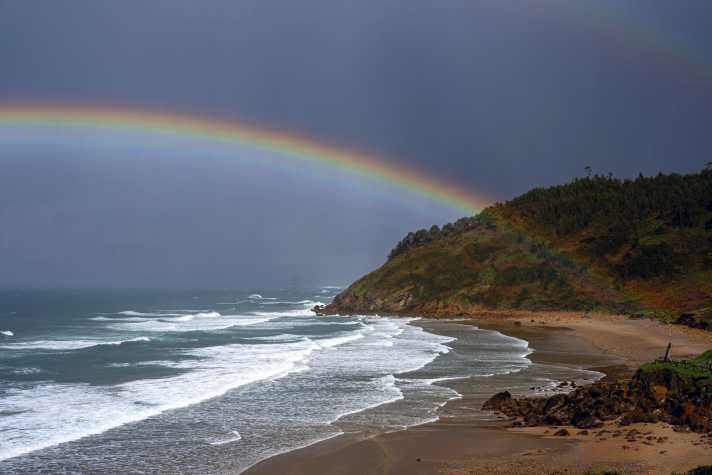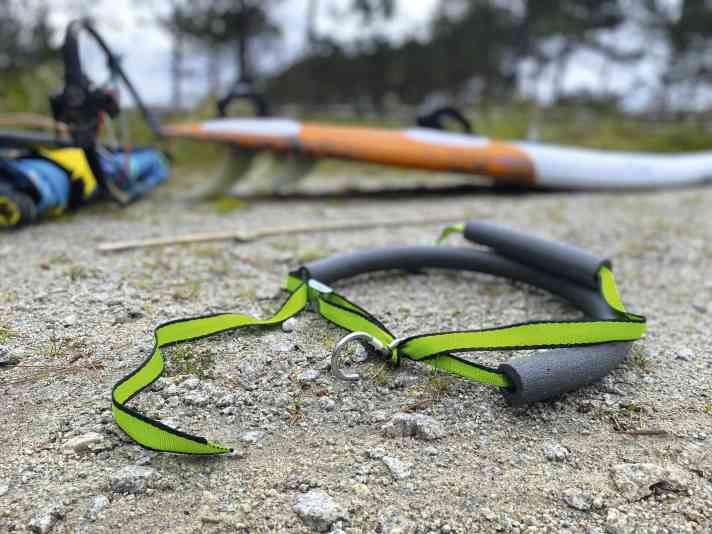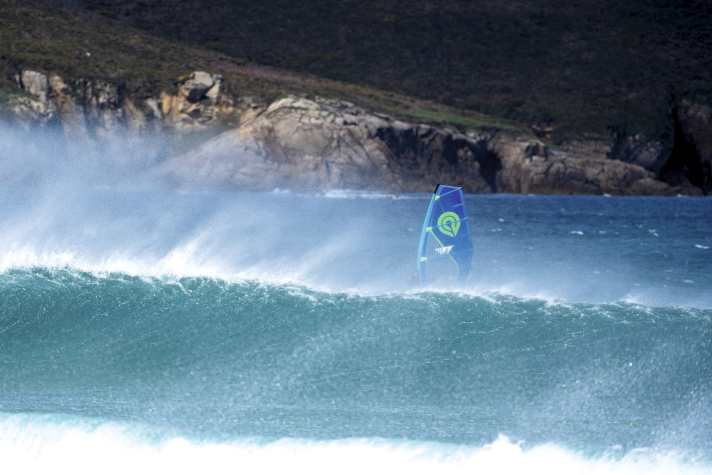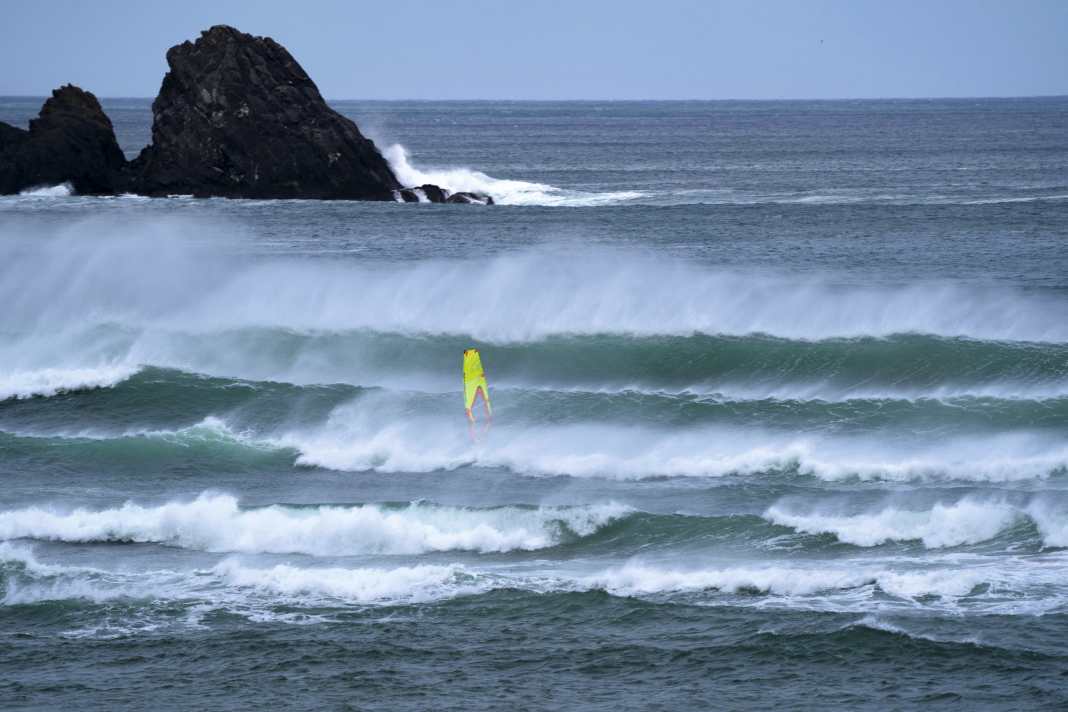Northern Spain, or rather Galicia, is no longer an unknown quantity in the windsurfing world, at least since Thomas Traversa's big wave adventures. So I travelled there and found out: If you set out on your own in search of rideable conditions that suit your own riding ability, you suddenly find yourself pretty much on your own.
Looking back: My first trip to the north coast of Spain was two years ago and I fell in love with the landscape, the climate and the incredibly good surfing conditions. Back then, we unfortunately only made it as far east as Cantabria because, contrary to the forecast, the waves just wouldn't stop, so we simply stayed there until the end of our holiday. Before that, however, I tried windsurfing once in the Basque Country, and the spot of choice at the time was the legendary Mundaka surf spot.
The Mundaka debacle
The forecast couldn't have been better at the time: Strong winds from the south-southwest and a relaxed wave forecast for Mundaka with a height of two metres and a 16-second period were predicted. I waited opposite the mouth of the Mundaka river for the low tide, which seemed to me to be the most sensible way to get through the waves in a controlled manner and not be pulled out to sea by the river. When the water is running out, the river mouth creates a pretty wild chop for the first 50 to 100 metres, but I was able to master it with ease. I patted myself on the back for my good timing in passing the waves. The peak with the surfers was already within reach, so I dropped off a little further so as not to get in the way of the locals. What's more, the wave that is popular with surfers is slightly downwind of the village, and it seemed hopeless that I would get a wave there anyway.
The glide ended abruptly and I found myself balancing on my board in the wind cover - just don't fall in now. "Actually, I should already be far enough out, and the wave further towards the beach would be enough for me," I mentally said to myself. Just then, the first tasty set came rolling in. "I'll take the second or third wave," I thought to myself, "then I can see how fast the first wave goes." Before I could think any further about my wave selection, the set was already in front of me and the current consideration was whether I should hold on to everything or let go. I decided to hold on, after all, I had already come across bigger waves on the North Sea. At that moment, I realised what a 16-second period means: significantly more wave energy! The first wave broke right into my lower leech and shredded my sail, leaving me a little frustrated on the way back. This had been my only windsurfing session in northern Spain so far, so it could only get better this time.

Galicia's coast of death with monster waves
On this year's trip, we wanted to go further than last time, so we only stopped briefly in Cantabria, grabbed the first waves and continued on to Galicia. A decent wind field nestled up against the most north-westerly tip of Spain. A strong southerly wind was supposed to blow around A Coruña for three days in a row. Unfortunately, I had forgotten my Stormrider Guide at home, but the crew at home were able to help out quickly via smartphone and send me useful descriptions. The strongest wind was supposed to blow through on the "Costa da Morte" (Coast of Death). The name didn't sound particularly inviting, and the swell forecast also looked more like death and destruction. I asked my mate Leon Jamaer, who had already been on a big wave mission in Galicia with Thomas Traversa, if he had any tips. Of course, he only knew big wave spots and some hollow-breaking monster waves. I'll leave that to the pros and those who feel the urge to self-destruct.
The name "Death Coast" didn't sound particularly inviting, and the swell forecast also looked more like death and destruction.
As the wind was really supposed to be blowing exactly from the south, sometimes even with an easterly gust, I had to go looking for it myself. The information from the Stormrider Guide and a Galicia spot report from surf magazine reported spots for winds from the north-east. So my evening programme consisted of checking all kinds of videos, pictures and reports and spotting the locations with the help of Google Maps. Unfortunately, there wasn't too much to discover, and the spots that Thomas Traversa surfs in his guided tour videos aren't really my cup of tea, at least not alone, as I hadn't seen any other windsurfers here yet.
Missing: Windsurfing harness
On the first windy day I checked Doniños, the spot was supposed to work in the south-west, and the wind was actually blowing from a slightly westerly direction that day. The waves looked pretty chaotic and there was no wind either. I waited another two hours for something to change, but somehow the spot didn't really want to get going. So I went one bay further to San Xorxe. Unfortunately, Google Maps had again recognised roads that weren't actually roads, so we almost got stuck in the middle of a muddy forest while searching for a spot. Overjoyed to have a tarmac road under the vehicle again, we reached the bay of San Xorxe. As we got out of the car, I realised that the wind was much stronger here, almost as if it was being amplified by the surrounding mountains. The waves in the middle of the bay looked pretty relaxed, so I decided to finally get out on the water and start chapter 2 of my windsurfing experiences in northern Spain. But things turned out differently.
Full of anticipation, I pulled my equipment out of the bus and tied everything up into a package so that I could carry it the few hundred metres to the beach. I quickly wrapped the harness around everything so that nothing could slip, and off I went...
Unfortunately, the time had come for me to realise that I had not only forgotten my Stormrider Guide at home, but also my harness. Cursing under my breath, I wandered around the bus as if it must be lying there somewhere, perhaps it would suddenly reappear as if by magic. Inwardly, of course, I knew that it was safe and sound in the cellar.
The do-it-yourself trapeze from the DIY store
Now it was time to think in a solution-orientated way and waste no time - off to Ferrol to the nearest surf shop. Unfortunately, after a 20-minute drive, I realised that although there were some very well-equipped surf shops here, they didn't stock any windsurfing equipment. At least there was supposed to be a windsurfing club in Ferrol, which I headed for without further ado. The whitecaps on the Ria de Ferrol in front of the club's premises didn't make things any easier - as a windsurfer, you quickly feel a bit of pressure in situations like this. The club's spot seemed to be more of a freeride or freestyle spot, and the club was taking a break, so I had to leave disappointed and without a harness.
In the midst of all the frustration, I suddenly had a flash of inspiration and headed for a DIY store with newfound confidence. Something with lashing straps would work, I just needed a hook that wouldn't bend open immediately, I thought to myself as I wandered through the various departments of the DIY store. I had already found tension belts and a suitable hook, and on the way to the checkout I discovered pipe insulation in the heating department that I could use as padding for the back. I briefly considered whether this was a bit excessive, but then allowed myself the luxury of two 95 cent pipe insulations.
I briefly considered whether that wasn't a bit excessive, but then allowed myself the luxury of two 95 cent pipe insulations.

Better back pain than not going surfing
Back in San Xorxe, I quickly made my first prototype and the whole thing made a pretty solid impression on land. My harness, which cost the equivalent of 7.50 euros, got me safely out through the surf and let me windsurf for about an hour. Admittedly: Afterwards I had a real backache, but it was still better than not windsurfing at all. The harness still needed a bit of tweaking as I had great difficulty unhooking again, but I still had two more days of windsurfing ahead of me.
On the second windy day, I went to the Ponzos spot, another bay a little north of San Xorxe. The wind was blowing quite consistently, but was completely offshore. The current, power and size of the waves were quite sporty. I watched two bodyboarders who were struggling to catch a wave at all due to the strong offshore wind. On top of that, there were some juicy sets that washed them back onto the beach and made them walk a few hundred metres back to the channel. Somehow I didn't have such a good feeling about it, so I headed back to San Xorxe. The waves were bigger than the day before, but the wind was blowing a bit more sideshore, so it should have worked out quite well. Unfortunately, the tide was pushing so much white water into the bay that it was impossible to get out at this point. So we packed everything up again and headed for Santa Comba, a bay next to Ponzos. Funnily enough, there were no waves here at all, although it was quite massive just a few metres further on. The last chance to get out on the water was in the southern part of the bay of San Xorxe, I thought.
Down-the-Line in San Xorxe
Once we got there, it finally looked navigable, the wind was also blowing very offshore, but the waves were not as big as in the centre of the bay. We didn't think twice, but rigged up and boarded the water with the trapeze, prototype number 2. The widened hook worked a little better than the previous version, so I was still able to enjoy great down-the-line conditions.
Before going to bed, I did some research on the Santa Comba spot I wanted to head for the next day and found out that it only works at low tide, so I checked all the tide tables again and went to bed.
On the third and therefore last potential windsurfing day, I was in Santa Comba just in time for low tide, and lo and behold: Sideoffshore and waves at a relaxed height quickly peeled over a flat sandbank. This time it seemed as if everything was finally going to fall into place, and the sun also showed itself to be merciful.
Santa Comba makes Galicia happiness perfect
The 30 or so surfing students, who were just getting changed, didn't want to miss out on the good conditions. That's all I need now! Finally good conditions, an acceptable harness set and then a crowded line-up full of surfing beginners. I cautiously asked the wild horde where they were going into the water, as it was very windy. Fortunately, it turned out that the group wanted to walk to the other end of the bay to surf in the shelter of a rock. Phew - what luck!
The following session was simply great fun: down the line - all alone! As always, because windsurfers are obviously a rarity here. If you look at the wind maps, northern Spain is actually quite well ventilated, but the many steep cliffs and hidden bays make it difficult to find a suitable spot. What is a paradise for surfing is a curse for windsurfing, as the beach breaks cannot withstand the swell that comes with the storms for long and then become chaotic.

Although the hook of my DIY harness cost me a good wave or two, I was at least able to go windsurfing a little with the temporary solution. As the water came up, the waves in Santa Comba disappeared again and I rolled up my sail with satisfaction. Unfortunately, it remained stowed in the car for the rest of the holiday, as the wind didn't come back. So you can go windsurfing in Galicia, even if you're not looking for a big wave adventure, the scenery is always beautiful and the temperatures in April were always around 15 to 20 degrees - just the right feel-good temperature for me as a northern light. Galicia, I'll be back! But then with a proper harness.







